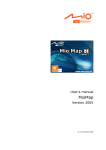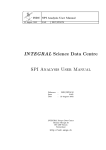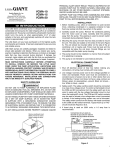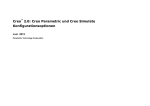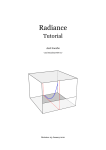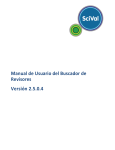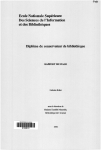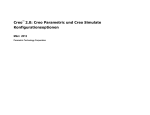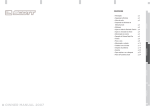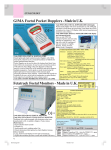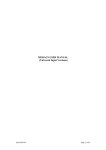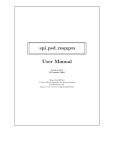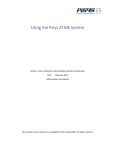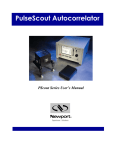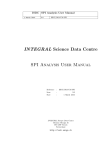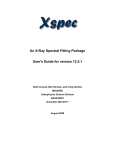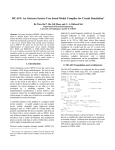Download Scientific Validation
Transcript
SPI ISSW Science Validation Report Page 1 of 21 SCIENTIFIC VALIDATION OF SPI INSTRUMENT SPECIFIC SOFTWARE Document ID: SPI-DAG-MPE-ROD-20020514 by SPI ISDAG / Roland Diehl Issue-1 14 May 2002 1. About this Document Scope Here we assemble the plans, methods, and results of the scientific validation of the SPI instrument-specific software as embedded in the software system for INTEGRAL data analysis at ISDC. We focus on instrument/system level here, and refer to supplementary scientific validation logs & reports and integration reports per ISSW tool for further details. Document History • 26 Mar 2002 Draft 1: planning, created from ISDAG MM and ISSW documents • 06 May 2002 Draft 2: including reports from data prep and imaging; for ISDC Mtg. • 14 May 2002 Issue 1: revised according to ISDC Mtg comments, for distribution 2. ISDAG's Software Validation Plan Validation Goals Comments: It was felt that starting to 'play' with existing tools would sufficiently guide the tester into the test objectives, and a sort of referee report on a tool area would be appropriate. Even though this approach is biased by existing software, it was felt that an initial step of generating a test/validation plan with an inventory of test questions and success criteria could be spared. "Validation" of ISDC Tools in general is understood to exercise a tool in a nearrealistic environment on near-realistic problems, in order to assess the adequacy of the functions provided, their quality and accuracy, and their usability. These criteria decompose into more technical aspects (does each sub-function execute without crashes or null-results on some test case), more user interface aspects (can I find functions and fill in their parameters and input data specs), and into accuracy aspects (are the quantitative results correct and consistent). SPI ISDAG 14.05.02 issw-scival_V1.doc SPI ISSW Science Validation Report Page 2 of 21 The task of validation therefore is split into these three aspects: • Technical validation of interfaces and basic functioning without crashes is a part of ISDC's software integration, hence performed by ISDC's Instrument Specialists • User interface and easiness-of-use validation is somewhat subjective, hence performed by SPI scientists, if possible different from the software developers • Accuracy validation has many levels, all to be assessed by SPI scientists. The developer made unit tests of the algorithm accuracy during development using available or mocked test data, which need to be complemented by broader validations within the full system using datasets prepared by other ISDC/SPI tools. It is the main goal to collect all this here, with different issues of the document presenting more and more of the completed work; early issues will list 'things-to-do' We address the performance under the themes of • Energy calibration and gain correction • Dead time and effective observation time • Energy resolution and spectral performance • Angular resolution, source separation power, and location accuracy • Field of view size and performance changes • Detection efficiency • Background characteristics (as far as prelaunch estimates go) Test Data Two sources of test data exist: (I) (II) Raw telemetry data from existing measurements, tailored for validation of some Preprocessing and Performance Analysis functions, and Calibrated-event data from sky simulations, which can be 'purpose-made' to validate specific Data Preparation and Science Analysis functions. Comments: Validation of tools on simulated event message data would be desirable in order to also test the data grouping and event binning functions; but resources are inadequate for such a big task. Eventtype data ideally should be simulated for a characteristic astronomical case, to follow this through the different tools. This involves adding time tags which correlate with pointing and their changes, and ensure the consistency of event data files with pointing files, and other aux data files. Pierre Dubath has been generating such file groups for the 'simulation pipeline' described earlier, and will check how much he can do to import simulated events. Chris Shrader together with ISDC will investigate if simulated events can be arranged such that the necessary aux data files can be generated. Provision of binned event matrices and the auxilliary files associated with these in the proper data group seems a realistic intermediate method, adequate for validation of the analysis tools. For the validation exercise, astronomical test cases are: - Crab source with a line feature and powerlaw spectrum: EBOUNDS, POINTING and DETESPECTRA datasets as FITS files, spectra in cts/bin. Crab-like power law source, with a superimposed 440 keV line, background spectral form resembling Jean et al 1997 superimposed (but scaled for exposure of 34.5 ks). (first provided Dec 2000; updated Feb 2002) - Cygnus region with set of sources with different spectra, and a diffuse component (simplified spatial pattern). 4 point sources, including 2 black-hole (Cyg X-1 and V404 Cyg), a neutron star binary (EXO2030+375) and Cygnus X-3 are modelled. (first provided Jan 2001; updated Feb 2002; no extended component yet) SPI ISDAG 14.05.02 issw-scival_V1.doc SPI ISSW Science Validation Report Page 3 of 21 Both test cases are implemented in a 5x5 dither pattern exposure. The exposure time is taken as ~105 sec. Background must be added such as to test the dependence of performance on signal-to-background ratios. Validation Task Distribution Existing ISSW functions are best grouped into categories. ISDAG assigned the validation task in October 2000 to Sites/Individuals: - Data preparation tools: GSFC/Bonnard Teegarden - Imaging tools (incl response and bgd aspects), generic: CESR/Laurant Bouchet - Imaging tools (survey aspects): - Imaging tools (source parameter and spectral aspects): MPE/Andy Strong - Imaging tools (diffuse sources aspects): MPE/Roland Diehl UBham&CESR/Gerry Skinner In practice, validations of different types were made by these and several other people, addressing (tbd) • (tbd • (tbd. SPI ISDAG 14.05.02 issw-scival_V1.doc SPI ISSW Science Validation Report Page 4 of 21 3. Validation Report General Findings Here we list observations which apply to the system as a whole, or to several of the tools. 1. The use of the ISDC system has a fairly high entry threshold: The user's environment must be carefully prepared and tested such that all environment variables are properly set and the access to software and data repositories works. There is no guidance on tool names at the beginner's level, names of tools must be known in advance. Familiarity with Unix features such as sophisticated 'grep' and 'emacs', and with utility features such as the 'fv' display options and tailoring are essential. It would be advisable to add an introductory primer / brief reminder, for the non-developers, where one finds the tricks how to know which tools exist and what they do, the general intro, format, and use of par files (see SPIROS SUM 3.1) and its editing with the available editors, some tricks for where files are expected and produced and how to efficiently organize this. All this is obvious for insiders and familiar to regular users, but the system should also cater for people who come from outside (where 'outside' means e.g. non-X-ray astronomers and/or non-programmers). 2. The tools themselves have often complex parameter lists, whose settings are not obvious from the prompt string; interactive help facilities are confined to an ascii help text file. Conditional use or ignorance of program parameters makes this even more complex. It seems that every task uses "hidden" parameters only. No ISDC standard seem to apply here, nor for the prompt style and value/default. The same is seen in the input/output data spec, were spiskymax prefers to provide input file specs, while spiros prefers to provide data groups. 3. Generation of representative test data is a major issue, obviously overlooked earlier in the project. Now one must resort either to simplistic exposure patterns implemented in 'simulation preparation tools', or be a real expert in the observation pattern implementation details of MOC and in ISDC file structures to be manually edited / composed. It would be desirable to have a few realistic standard cases prepared for all instruments by such experts, with help of MOC; cases would be "the PV phase Cygnus exposure", "the Crab calibration exposures", "the GCDE core program of 1 year", "the Galactic-plane-scan". 4. Finding out about the causes of program crashes always turns out a major exercise. Too little support is supplied, and programs are not gracious, collapsing from very simple par file typos with cryptic error messages but still producing output files (see next). Then several tools flood the screen with debug/dump messages which do not mean anything to a general user; the diversity of program log messages and debugging levels and their use is painful. 5. A most common reason for crashes is the non-existence of input files, or the existence of output files from a previous (possibly crashed) run of the tool. Searching and finding such user mistakes is cumbersome and made even more difficult through uninformative error codes (numerical code only) by the DAL. Much more user friendly DAL functionality is considered important. SPI ISDAG 14.05.02 issw-scival_V1.doc SPI ISSW Science Validation Report Page 5 of 21 Specific Findings Here we list observations which apply to a specific tool; we group tools according to analysis levels. Test Environment Preparation and General System Use 1. User instructions were absent or scattered in places not obvious to the nonregular user if the ISDC system. Consult http://isdcul3.unige.ch/Instrument/spi/ for user instructions (but this is meant for the BLC processing pipeline). Consult BLC or ROT (!) User Manual www pages, follow its setup instructions: create data_rep and par_files directories and the desired subdirectories. Set env for login and PATH etc (no idea what I am doing here in detail). Seems to work. Copying all *.par files is recommended, but generates a lot of unnecessary mess in my working directory; better point to 'templates' for general use, or provide them where the help facilities are. But then a Program (here: GENSKY) does not use the current par file, one needs to set "setenv PFILES ." - nobody said that before. The log/dump of many programms is excessive and flies by; re-direction to a log file may cover-up the problem, but how? Need a system environment setup manual. 2. Availability of tools: From one day to the next, this same setup procedure did not work any more, "gensky: command not found". I search around for the gensky program, do not find it nor can I find a reason. I am stuck! Some strict configuration control needs to be implemented soon. 3. User Manuals of e.g. spidiffit, spiskymax, spiros are available. But all are manypage ps files, so no edit/search possible. The SPIROS cookbook alone is 32 Mbytes, minutes to download before one can see what it is about. Attempting to invoke task help files through "<task> --h" results in error messages only, so I cannot proceed without paper user manuals. 4. General tools: "fv" must be invoked with a strange option "-cmap 2"; why this complication? Preparation of Data for Scienctific Analyses og_create: Currently, this uses a txt2idx preprocessor to create an index of science windows. While adequate for the calibration runs, where not more than a few scw's are typically combined this is adequate. For real observation scenarios, a more powerful utility, perhaps incorporating a GUI interface is needed. spi_gain_cor: There are few programable inputs to this program, so its usability is straight forward, and not much to assess. We did compare the results of spi_gain_corr directly against spihisto (Toulouse version) for various runs and several event types, and find perfect agreement in all instances. We had some confusion over the "cleaned" PSD/multiple events, in terms of the definition of their selection criteria and bookeeping impact on other multiples. This confusion was nominally resolved by reading "between the lines" in the ICD. Performance is a concern. Even for single science window analyses, this was evident. spidead: Straight forward to use; no specific problems to report. However, at the moment seems to apply a somewhat arbitrary scale factor (independent of detector, event SPI ISDAG 14.05.02 issw-scival_V1.doc SPI ISSW Science Validation Report Page 6 of 21 type). At some point, an attempt at a physics oriented deadtime calculation needs to be implemented. spipoint: Straight forward to use; no specific problems from our perspective. spigti: We had early problems with time windowing, as pertains to spihist event selection, but this is now resolved. spibounds: Straight forward to use; no problems to report. Offers flexibiliy in binning schemes to support scenarios unique to gamma-ray line studies; line region(s) can be densely sampled while continuum regions coarsely binned. spihist: (no third party assessments yet). spihisto: The only significant concern we had was with the event handling logic for multiples; specfically, they are binned as separate events (e.g. doubles, E1 in Det 1, E2 in Det2) rather than as a photopeak event in the appropriate pseudodetector. This was problematic in our response studies. gensky: With 'debug=silent' I get lots of message dumps, not at all "silent". GENSKY does not apparently have a manual, so no help on the parameter meaning. Parameters questions: "debug": what is the difference between 1,2, which categories of output can I choose from? - "Display": what is the difference between 1,2? "Sources": how do I distinguish point sources from Gaussians? - "Source components": I have a parameter "spectral index", and a "line width" - what do I choose for either a powerlaw or a line, here, respectively? GENSKY ran ok, but did not have the proper input file (diffuse emission map), and did not complain, and produced an output sky image which turned out empty. (Or did it, in the flood of dumps?) GENSKY does not allow for powerlaws with cut-off as spectral shape; need to approximate the Cyg region sources simulated by the GSFC group with powerlaws. GENSKY only allows for fixed energy binwidth; logarithmic binwidths are more appropriate for many steep-spectrum sources. The powerlaw spectra need to have proper units and corresponding normalization, not always simple, no warnings. os_pdefgen: needs to be run to get the ATTItude history file. Parameters: dither pattern definitions are redundant and many do not actually work. Using the standard GCDE code (9) produces an error of some odd number code -18110, and complains about improper specification. Trying Galactic coord's also comes with strange error messages about inadequate specification of "Z1", which is none of the parameters. In any case, the generated image always is calculated in RA/Dec, one cannot change that to Galactic. So, generating the desired observations composed of sets of standard 5x5 dithers or the GPS, GCDE was not possible. For the Cygnus simulations, chose the XRA/XDEC parameters for the fov axis, standard 5x5 dither; but no idea about settings of the position angle and z coord spec's, leave them at default. Crash SPI ISDAG 14.05.02 issw-scival_V1.doc SPI ISSW Science Validation Report Page 7 of 21 "segmentation fault" after "I understood…" messages which don't mean anything to me, caused by user spec of RA in degrees while the program expected hh mm ss; the parameter instructions could be clearer here. spisimprep: runs ok, generates GTI, deadtime, etc. Apparently, the GSFC-simulated aux files do not quite match these file formats, however: although the ATTI files look identical when plotted, spiskymax refuses to accept the input files from the GSFC cygnus simulation (why? No idea, all combinations of available files tried). spiback: Error No 2004 finally was found to mean that a detector-event spectra file (evts_det_spec.fits) was missing: this is an empty dummy according to AWS, but must exist. The SPIBACK help file is inadequate, it plainly refers to "the ICD" for an explanation of the parameters, this is not helpful at all. Otherwise spiback works. Apparently however the present version only can use pre-set bgd levels, no connection/scaling with aux parameters is supported. spiskycnv: Needs responses (IRF) as stored in Andy Strongs private directories; where would I find the ones to be used? I now chose that SPISKYCNV interprets the gensky-image in Galactic coordinates (see above). This concept, that the map can be interpreted in different coordinate systems and hence can mean very different things, should be reconsidered; invitations for errors? It is not prominently stated that HERE the gensky map and the spiback background are combined to produce the simulated dataset; so beware that spiback has been properly applied before spiskycnv is run. General Remark on Test Data Provision at this Level In ongoing work, GSFC have produced new simulated data sets, using our SPI model integrated onto TIMM3.4, to assess the effects of a bright off-axis source passing through the IBIS (i.e. the "SPIBIS" instrument). These data can be treated separately, or combined with the Cygnus region data to assess the total effects. GSFC are also working on a set of mono-energetic point source simulations to determine the optimal response matrix for use with spiros spectral extraction. In addition, GSFC will in the near future be generating background spectra to be included in the spiros/XSPEC analysis. The spiskymax user manual contains a very useful general instruction set on how to prepare data for testing and validations. Should this be moved elsewhere into a more general user manual? Imaging Sources and Surveys spiskymax: Nice user manual! Contains a lot of useful stuff, specifically the algorithm, log of an example, and more examples, all in one place. A copy of the source catalogue is needed for spiskymax. Its real use here is not obvious, no directions found; an attempt to edit the catalogue with fv fails, file not writable. SPI ISDAG 14.05.02 issw-scival_V1.doc SPI ISSW Science Validation Report Page 8 of 21 The specification of the sources for which a parameter analysis is made is irritating: It is stated that the catalogue is used, but why then not remove all these parameters in the par file? Find out later that ONE source spec must still exist in the par file, so that catalogue is used; hm. - Once this is solved, the sources are recovered and imaged as put into the simulations. Outputs are fine. Trying to image the GSFC simulated data fails: SPISKYMAX produces empty images. Using the debug flags was hopeless: floods of output on the screen, too fast for me. spiros: GSFC: I have run spiros in imaging mode for a number of scenarios (Cygnus region point sources, mono-energetic point sources at variosu energies, offaxis angles). For Cygnus, the fainter, softer sources were not well determined (even though there was no background included). I had difficulty performing followup runs in spectral mode. This seems to be a DAL file management problem, rather than a spiros-specific problem. Performance and memory management are a concern. For a small (9 energies) set of IRFs the image reconstrution for a single point source (with no background) took about 10's of minutes typically. The new (just delivered) set of IRFs cover 50 energies, and we need in the near future to include background determination in the image reconstruction tests. spidiffit: (no third party assessments yet). Spectral Analyses spiros: (no third party assessment reports yet). spiskymax: (no third party assessment reports yet). spidiffit: (no third party assessment reports yet). SPI ISDAG 14.05.02 issw-scival_V1.doc SPI ISSW Science Validation Report Page 9 of 21 4. SPI Science Performance Parameters Here we assemble the SPI instrument performance parameters as obtained through analyses of calibration and simulation data with the ISDC/ISSW tools. We attempt to follow the parameters as identified in the "SPI Science Performance Report". Yet, in that document the emphasis is placed on the instrinsic hardware / detector performance parameters, while in this document we review the performance that can be expected from the realistic mission situation with its exposure patterns and after standard analysis tools have been applied to generate results. Energy calibration and gain correction (tbd) Here we would like to have fitted energies from preprocessed event data, gain-corrected with standard tools after fitting the predefined set of background lines with the standard calibration analysis tools; a table with the achieved energy scale accuracy versus energy is the goal. CESR? Dead time and effective observation time (tbd) Difficult to test these without real data. AWS simprep tools' review? Use of BLC data, after their embedding into simulated obs pattern? Goal is to demonstrate that identical source intensities are recovered under different deadtime / countrate conditions and with different observation patterns. MPE and CEA? SPI ISDAG 14.05.02 issw-scival_V1.doc SPI ISSW Science Validation Report Page 10 of 21 Angular resolution, source separation power, and location accuracy 60 Fig x1: Co spiskymax image, source distance 125 m, event types 'singles and doubles and triples'. No ghost images appear (left), the expanded view on the right side shows the accuracy and width. The middle image was derived from all event types, while the righthand image was derived from 'double and triple' events only. Fig x2: spiskymax images for different source energies, source distance 125 m, event types 'singles 241 137 and doubles and triples'. Sources are Am (left, 59 keV, on-axis), Cs (662 keV, center, at 2° 24 aspect; see below for variations across the field-of-view), and Na (2754 keV, right, on-axis). 60 Fig x3: Co spiskymax images, source distance 125 m, under different viewing conditions: Source aspect rotation by 30° (left), and viewed with 11 pointings with different aspects (center, and expanded view right). From BLC calibration measurements, imaging analyses indicate the accuracy and width of the point source response. Note that the source beam divergence is 8', hence the source is not at infinity as cosmic sources will be. From a single source exposure, the achieved angular location precision at 1173 keV is better than 12' (figure x1), the width of the residual extent in the spiskymax image SPI ISDAG 14.05.02 issw-scival_V1.doc SPI ISSW Science Validation Report Page 11 of 21 60 Fig x4: Co spiskymax image, sources distance 125 m, event types 'singles and doubles'. Here available source aspects were combined such as to effectively emulate a multi point dither pattern. The left image shows a single source, viewed by 11 pointings. The center image shows two sources separated by 2° and viewed by a single pointing. The righthand picture shows how emulated dithering with 5 dither pointings improves imaging of these same two sources with 2 degrees separation. is 36'. Even when using only multiple events, this degrades only to a width of ~1.2°. The energy dependence of this performance is relatively weak, as the results at 59 keV, 662 keV, and 2754 keV (Fig x2) indicate. Rotations in viewing appear to be handled correctly by analysis software, the result is unaffected (Fig. X3). Combining calibration exposures such that more than one source appear in the field of view, the imaging results from dithering observations, and the multiple-source separation power was tested. From the available BLC source aspects, for a single source an 11-point dither pattern could be emulated (Fig x3). It is evident only that dithering observations will allow the specified source separation power of < 2° (see Fig. X4). A resolution power of 1° is demonstrated on these practically backgroundfree data. The performance for different energies, signal-to-background-ratios, and event types is (tbd) A test on reducing the BLC source intensity by photon sampling shows the degradation of angular performance (and flux recovery) with signal-to-background ratio (see table). Location Flux RA_OBJ DEC_OBJ ERR_RAD Flux Taking Flux Source uncertainty 1 photon in (derived) signifcance -0.0017 -0.0320 0.0038 1.6031 0.0040 1 1.603 (σ) 403.5 -0.0032 -0.0271 0.0053 0.8000 0.0028 2 1.600 285.7 -0.0016 -0.0322 0.0077 0.4016 0.0020 4 1.606 202.1 -0.0025 -0.0133 0.0104 0.1985 0.0014 8 1.588 142.4 0.0030 -0.0812 0.0164 0.1019 0.0010 16 1.630 101.3 -0.0129 -0.0293 0.0162 0.0999 0.0010 16 1.599 100.5 -0.0064 -0.0148 0.0154 0.1011 0.0010 16 1.618 103.8 -0.0157 -0.0417 0.0163 0.1001 0.0010 16 1.602 99.0 0.0004 -0.0312 0.0141 0.1023 0.0010 16 1.637 102.6 -0.0030 -0.0438 0.0159 0.1009 0.0010 16 1.615 102.0 0.0224 -0.0222 0.0223 0.0504 0.0007 32 1.613 71.8 mean -0.0019 -0.0335 0.0131 rms 0.0098 0.0184 1.610 0.014 Table 1: Results from Spiros on source location and recovered flux, taking BLC data for 137Cs and reducing the source significance by successively reducing the number of photons by taking random selections SPI ISDAG 14.05.02 issw-scival_V1.doc SPI ISSW Science Validation Report Page 12 of 21 Fig. X5: Images of simulated celestial sources in the Virgo region as observed with realistic dither 6 pattens and background. A spiskymax image for the 3C273 and 3C279 quasars simulated with 10 sec exposure in a standard 5x5 dither pattern with 2° separation is shown on the left side in the 4001000 keV energy band. The righthand image shows a spiros image at low energies (50-150 keV) from a simulation of 3C273 alone, with realistic background, and an 11x11 point dither pattern. Fig. X6: Images of simulated celestial sources of the GC region sources observed by SIGMA by spiros in 'source' (left) and in 'imaging' modes (right), at 50-150 keV, observed with a 31x31 point dither pattern with 2° separation which would be typical for the deep inner Galaxy core program observations (images tbd) Fig. X7: Images of simulated celestial diffuse emission of the Cygnus region, observed with three 5x5 point dither pattern with 2° separation which would be typical for the planned commissioning-phase observations. The image adopts the COMPTEL result as a model for celestial emission (left). The repoduced emission from spiskymax confirms that mapping of diffuse emission needs ~Msec exposures. Here we want to use BLC data for two energies (~0.5 and ~5 MeV) and produce images for the 1 and 2° separated cases as in Fig x4, mixing to these data typical backgrounds to simulate 10-day and 5-month exposure cases with the available 11-point dither. Images would be produced for singles, doubles, triples, and all-types. CESR/MPE? With simulated data from adopted celestial source distributions, it could also be demonstrated that imaging tools handle larger sets of different pointings. The standard 5x5 point dither pattern was tested on sources in the Virgo region, while the 31x31 point dither pattern typical for the exposures of the inner Galaxy in the GCDE SPI ISDAG 14.05.02 issw-scival_V1.doc SPI ISSW Science Validation Report Page 13 of 21 part of the core program were tested on sources and extended diffuse emission in the inner Galaxy. In these cases, also the treatment of background was tested, adopting an expected background count rate which was derived from mass model simulations (Jean, 2001). Figure x5 shows the Virgo region quasar images with SPI imaging tools which could be expected from the Virgo region quasars 3C273 and 3C279. Figure x6 shows the hard-X ray sources in the Galactic-Center region as imaged with spiros. Figure x7 shows a spiskymax image of diffuse emission from the Galaxy. Fig. X8: Image of simulated celestial diffuse emission of the Galaxy, observed with a 31x31 point dither pattern with 2° separation which would be typical for the deep inner Galaxy core program observation. This image was derived from a Gaussian-shaped model (left) in the 100-400 keV range, with the equivalent of 1 year of exposure. Beyond those functional tests, we simulate imaging of a sky region with a large set of separated and different observation patterns as would be typical for combining data from surveys and open-time proposals. (TBD) 3 The goal is to combine GPS, 5x5, hex, and GCDE pointings with totally ~10 pointings of totally ~1Msec exposure and a realistic background level. CESR? The performance is measured in terms of recovered source location, its error, and source flux, & its error, shown as a function of number of pointings, pointings pattern offset from instrument axis, and energy. Result table tbd. SPI ISDAG 14.05.02 issw-scival_V1.doc SPI ISSW Science Validation Report Page 14 of 21 Field of view size and performance changes The BLC exposures of a 60Co source at 125 m distance at aspect angles from onaxis out to 10° were imaged with spiskymax. Although the source locations are within expectations, interference patterns between mask and detector alignments become obvious (see Fig x5). Note that this demonstrates the instrument's response 60 Fig X5: A Co source at aspect angles between on-axis and 10 degrees (from top left to bottom right: 0°, 2°, 4°, 6°, 8°, 10°) characteristics, if staring observations only would be used. The SPI dithering observations are made to properly measure the same sky region under different aspects, in order to eliminate these response feaures from the resulting image. For assessment of the field-of-view size and the changes in imaging performance within inner and outer field of view, simulated data must be used. A standard 5x5 point dither pattern was used. Response data were used at a grid of (tbd). The imaging location and flux accuracy versus source aspect angle and signal-to-background ratio are summarized in table (tbd) MPE? The source flux recovery versus source aspect angle is indicated from analysis of BLC calibration runs with the same source at different aspect angles Fig. X5a). Recovered Source Fluxes over SPI Field of View 2 1.8 Flux (cm^-2 s^-1) 1.6 1.4 1.2 1 0.8 0.6 0.4 0.2 0 -4 -2 0 2 4 6 8 10 12 Source Aspect (deg) 60 Fig X5a: BLC Co source fluxes (1173 keV) as recovered with SPIROS for different source aspects. Source distance is 125 m. SPI ISDAG 14.05.02 issw-scival_V1.doc SPI ISSW Science Validation Report Page 15 of 21 Energy resolution and spectral performance The spectrum recovered from analysis in different energy bands tests the global energy dependent analysis in imaging approaches. …. Fig. Xx: Spectral recoverage of simulated sources: Top Left: spiros reconstruction of 4 simulated sources in the Cygnus region, 1 day of observation 5x5 point dither pattern. Top Right: spidiffit reconstructed spectrum of diffuse emission in the Galaxy, viewed with the 31x31 point dither of the GCDE over 1 year of exposure. Bottom: SPIROS analysis of a Crab-like source with line features added artificially. Alternatively, direct spectral fitting using the fine spectral response is performed with XSPEC. This is considered the baseline approach for astrophysical studies, beyond the straight data analysis presented with the imaging tools in narrow spectral bands. (Here we do not really have verification of ISSW as installed at ISDC, only prototypes with tailored and reformatted data; an assessment of real ISDC tools is tbd) SPI ISDAG 14.05.02 issw-scival_V1.doc SPI ISSW Science Validation Report Page 16 of 21 Detection efficiency The detection efficiency results in the correctness of the recovered source fluxes. This could be tested/verified on prelaunch calibration data from BLC through comparisons of the predicted versus measured detector counts: If the response matrix is correct, the resultant image from deconvolution analysis quantitatively "predicts" the data, and these can be directly compared to the measurement using Poisson statistics as statistical uncertainty measure. Within statistics, the match is acceptable (see Figure x12). Fig x12: The count data space (counts per each of the 19 detectors) tests the correctness in absolute terms of imaging deconvolution, respectively the consistency of the response as used. Here for the 60 Co on-axis measurement at BLC the predicted counts after imaging are compared to the actual measurement. The detectors are identified in numbers for single events (0-19), doubles and triple events (>19)(left); the comparison to the actual measurement is perfect (right). Note that the analysis includes a fit of background, assumed to be constant but specific to each detector. Absolute source flux recoveries for BLC data with spiros were compared with the incident fluxes as derived from analysis of a reference monitor detector with a rather well-known efficiency (see table). Within uncertainties of both measurements, this preliminary analysis indicates that absolute efficiency is properly handled. Source / Energy Incident Flux Recovered Flux 241 Am / 59 keV 0.681 0.725 137 Cs / 662 keV 1.74 1.44 60 Co / 1173 keV 2.11 1.54 60 2.22 1.70 Co / 1332 keV Degrading the incident flux of a BLC calibration run, it was demonstrated that the recovered source flux with SPIROS is retained (see table 1 above in Section about Angular Performance) A more refined analysis, based on the known source intensities improving the accuracy of incident photon fluxes, results in source detection efficiency versus energy as obtained with analysis tools as shown in Fig tbd Background characteristics (as far as prelaunch estimates go) (tbd) SPI ISDAG 14.05.02 issw-scival_V1.doc SPI ISSW Science Validation Report Page 17 of 21 Required Actions for ISSW Developers & ISDAG Documentation and User Friendliness: Stimulate ISDC to add GUI's to each major/highlevel tool (such as "imaging analysis for SPI"), which provide access to functions and subfunctions, help texts and result investigation methods, a tool parameter database, and support semi-automatic assembly of dataset identifiers wherever feasible. Then each developer needs to tailor the *.par file template to make proper use of such a GUI and guide the user into the entry of proper control parameters. Also, the help texts and -files need to be reviewed for a more homogeneous approach, now that a set of good examples exists. Test Data Provision: For validation of the capability of tools to handle real mission data it is required to have a test dataset which is characteristic for the real mission. As a minimum, the PV phase observations in the Cygnus region should be translated into the proper auxilliary files as one would receive from MOC or generate from real data at ISDC. For the completion of science validation of the SPI performance achieved through data analysis tools, specific cases need to be simulated (see next point). Science Validation Completeness: As evident from above Chapter on the SPI Science Performance Parameters, many aspects have not need validated in the quantitative way needed for release of data and software to external scientists. This includes most prominently the performance under more realistic signla-to-background ratios, i.e., mixing background data to either BLC calibration runs or otherwise simulated data. Then, the performance aspects of angular resolution, spectral performance, and source flux recovery shall be assessed as a function of energy, source aspect, event type, and observation patterns. Remaining Activities and Planning Item Documentation User Support Test Data Action Help&Parfile Revision Support GUI & Scripts for par Realistic Observations Test Data Science Validation Science Validation Science Validation Science Validation Science Validation SPI ISDAG Completion Oct 2002 Oct 2002 Jul 2002 Sci Val Aspects Angular Performance Actionee Developers Developers ISDC w MOC ISDAG ISDAG Spectral Performance ISDAG Oct 2002 Efficiency & Sensitivity ISDAG Oct 2002 Background Handling ISDAG Oct 2002 Deadtime & Observation Patterns ISDAG Oct 2002 14.05.02 Aug 2002 Oct 2002 issw-scival_V1.doc SPI ISSW Science Validation Report 5. Annex A: Page 18 of 21 ISSW Tool Overview We distinguish as categories of the ISSW, from the user's point of view: 1. ISSW tools for data decomposition and preprocessing 2. ISSW tools for instrument performance analysis 3. ISSW tools for near-realtime analysis of bursts and transients 4. ISSW tools for instrument calibration and response determination 5. ISSW tools for background analysis and modelling 6. ISSW tools for preparation of data for astrophysical analysis 7. ISSW tools for astrophysical analyses, in the areas of imaging, spectra, timing, and model fitting Preprocessing and routine monitoring parts of this system is ISDC-specific, and response/calibration- and performance analysis parts are specific to project-related sites and the ISDC, while science analysis parts of this software may be distributed to the community with the data. ISSW tools for data decomposition and preprocessing The SPI-specific telemetry aspects have been encoded into ISDC's 'Preprocessing' software, based on the SPI Science Data Format Description. ISSW tools for instrument performance analysis The SPI scientific performance is monitored with ISDC's "OSM" (observation status monitoring); this is a root-based package, with an "automatic" and an "interactive" implementation. Interactively, a variety of user-specific displays can be built and saved for later usage. This "interactive OSM" is also used by SPI experts for their deep science performance analysis work at ISDC and remotely. Specific OSM displays are provided for the SPI hardware subsystems, such as the Anticoincidence System (ACS). For subsequent science analysis, the results of performance analysis are condensed into "good time intervals" datafiles. The ISDC package SPIGTI includes algorithms to translate SPI mode transitions into corresponding entries; algorithm adaption occurs through software changes. ISSW tools for near-realtime analysis of bursts and transients In order to monitor incoming data in near-realtime for the detection of gamma-ray bursts and transients, special ISSW has been tailored for the ISDC of the IBAS (for realtime burst detection) and QLA (for daily quick-look analyses to search for transient sources). The IBAS ISSW features a branch for monitoring the ACS detector rates, and a branch to monitor Ge camera detector rates. Glitches exceeding a significance threshold above a running average are used to signify a burst. The QLA software for SPI is a tailored derivative of the SPIROS imaging/source search algorithm (see below), optimized for performance and catalogue interfacing. It processes a reference catalogue of expected sources with their characteristica, and outputs a list of discrepant/new sources. SPI ISDAG 14.05.02 issw-scival_V1.doc SPI ISSW Science Validation Report Page 19 of 21 ISSW tools for instrument calibration and response determination The raw Ge detector event messages are pre-processed into calibrated event messages, based on gain correction factors derived through instrumental-line fitting analysis. For this, incoming raw events are histogrammed (ISSW module SPIHISTO), line fitting (ISSW module SPILINE) then determines the gain correction factors (ISSW module SPICALI). Similarly, from Performance Analysis a set of assessed PSD calibration libraries is maintained, from which the PSD classification criteria are derived. Both the gain correction and PSD classifications are applied (ISSW module SPICOR) when the events are read/used for science analysis, e.g. when binned into spectra for later analysis (ISSW module SPIHIST). The instrument response of SPI is determined solely from Monte Carlo simulations of the physics interactions within instrument and detectors. The MGEANT software package is used to handle the physics details and produce physical interaction events. The SPI response is determined as a function of incidence direction and energy. The different variabilities of response aspects with angle and energy is accounted for by decomposition into different matrices (L, D), one addressing the detailed energy response of detectors, the other addressing the attenuation of gamma-rays from all incidence directions on their way to the Ge detectors. The ISSW module RSPGEN composes these matrices to assemble a response function representation as needed for different purposes, i.e., for spectral analysis or for imaging analysis. The basic response matrices L and D are provided to ISDC by GSFC of the SPI Team. The RSPGEN module uses these and makes the necessary interpolations, instrumental-preformance adjustments, and formatting to provide imaging response matrices (IRF) for the SPIROS/SKYMAX/DIFIT imaging analysis modules, and spectral response matrices (ARF, RMF) for XSPEC spectral fitting. ISSW tools for background analysis and modelling Instrumental background is large for any instrument in the MeV regime, from cosmicray activation of spacecraft material. Basic/standard spectral analysis software (e.g. from CERN packages as part of the ISDC ROOT scripting language; but also modules have been provided as part of the ISSW, such as SPILINE, or GASPAN) is used to identify characteristic spectral lines and thus explore the background types. Fit results must be digested interactively by instrument scientists to derive background parameters; no direct interface to background modelling is foreseen (see below). For detailed Monte Carlo simulations of background, both the MGEANT package (used also for the response simulation) and the TIMMS implementation of GEANT with enhancements are available. External particle radiation environments are specified by the user, the detailed mass models and response functions included in these packages then generate the simulated Ge detector event messages as expected from such background. Studies performed at CESR (Pierre Jean) and CEA (Nene Diallo) constitute a baseline for SPI instrumental background. More must be learned during the mission from comparisons of background explorations with simulations. Background handling in the science analysis software occurs through fitting of the amplitudes of background model tremplates prepared from above knowledge. The ISSW module BGDGEN includes several analytical background model representations, as well as an interface to a simulated or otherwise obtained background template; also, correlations to auxilliary parameters from the INTEGRAL housekeeping database (e.g. radiation monitor countrate) can be used in BGDGEN. The output of BGDGEN is a background model for imaging analysis, whose SPI ISDAG 14.05.02 issw-scival_V1.doc SPI ISSW Science Validation Report Page 20 of 21 amplitude should be determined however within imaging analysis to account for correlation of source signal and background in the actual measurement. No special ISSW is provided for background modelling in spectral and timing domains; this is addressed by spectral and timing analysis software directly. ISSW tools for preparation of data for astrophysical analysis Before astrophysical analyses, the measured data together with auxilliary data and responses must be collected and prepared as a data group. Beyond interactive identification of the relevant data intervals, and using ISDC general utilities such as OG_CREATE, several ISSW modules are involved here. The instrument pointings on the sky are assembled by ISSW module SPIPOINT. Instrument deadtimes for the time intervals in question are derived from housekeeping rates of the instrument through ISSW module SPIDEAD. Proper uncontaminated data intervals are derived with SPIGTI (see performance analysis). Imaging responses and background models are tailored to the analysis data sets with ISSW modules SPIBOUNDS (define binning constraints in general terms), BIN-I (define the binning used in analysis), IMG-I (prepare the response matrices in appropriate binning), and BGK-I (prepare relevant background model). The measured data themselves are binned into histograms for science analysis, using ISSW module SPIHIST. Utilities for interfacing to previous knowledge about the gamma-ray sky are provided for diffuse emission (skymap convolution, ISSW module SKYCNV, with preparation of the sky parameters in module GENSKY) and for source calalogues (ISSW module CAT-I). ISSW tools for astrophysical analyses, in the areas of imaging, spectra, timing, and model fitting The most general and theoretically also most sensitive analysis would make use of the full data in unbinned form (to retain measured resolutions), and use the instrument response in full spectral and spatial detail to deconvolve the appearance of the sky. Response information would be too complex and big to be handled, however, so that compromises are necessary. For imaging analyses, one assumes the separation in wide energy bands is adequate to not distort results from adjacent energy bands. For spectral analyses, one either attempts to separate a source direction through a first round of imaging which generates "selected source spectral data", or else assumes that spatial data selection and subtraction can be made to isolate the spectral signal from the source of interest. For timing analyses, similar considerations apply; here often one isolates the source signal only through its unique signature in the timing domain, and empirically defines the flat timing signature as the background from the rest of the sky and the instrument. Imaging Analysis Two methods for generation of images are provided: Iterative removal of sources from high to low significance (ISSW module SPIROS), and sky deconvolution with account for image entropy (ISSW module SKYMAX). SPIROS determines parameters (flux, significance, spectrum) for each identified source, hence aims at point-like sources primarily. SKYMAX treats the sky as pixelized intensity map, hence aims at diffuse emission primarily. Both packages are capable of imaging the sky with point-like and diffuse emission together, within these constraints/compromises. SPIROS: The package searches for a sky correlation of the instrument response with a strong point source. Upon finding it, the corresponding expected signal from this SPI ISDAG 14.05.02 issw-scival_V1.doc SPI ISSW Science Validation Report Page 21 of 21 strongest source is subtracted from the measured dataset, and then the search is continued for the next-strongest source. At the end, a list of identified sources exists, which, in the final analysis step, is used as input to fit their intensities in combination through a maximum-likelihood method. The user may start with an "expected" sky which may be composed of diffuse emission and point sources; also, background model templates can be provided and are used in all search and fitting steps. Diffuse emission and source patterns can be controlled through choices of coordinate systems / spline functions. SKYMAX: The package iteratively modifies the inputs sky such as to improve the data fit after convolving with the instrument response, using the entropy of the inputs sky as a second criterion in order to damp fitting of the noise. The gradient search method is complex due to the large number of free parameters (each sky pixel). Iterations are terminated once noise is found to dominate, which I detected through internal Monte Carlo simulations. The user controls search method details, but most importantly the entropy reference, through provision of the input / starting map. Results are provided in the form of image and image projections. Model Fitting: Two ISSW modules/packages are provided to determine intensity parameters of sky intensity models from SPI measurements: a Maximum Likelihood fitting method, and a Markov Chain Monte Carlo method source model fitting. In these modules, fitting methods and fit parameter constraints are controlled by the user, in addition to the variety of spatial intensity model formats which can be provided/used. Spectral Analysis Basic spectral analysis is supported through the tools mentioned above, for performance analysis and inflight calibration/gain analysis, and background exploration. Astrophysical spectral models are fitted to data by the X-ray community through the XSPEC software package. This package, also part of the ISDC tools, is enhanced (XSPEC Version-12) to support the more complex inclusion of imaging and spectral responses simultaneously. With this, the response to each source in the field of view can be used to fold its expected spectrum into dataspace, so that for the source in question astrophysical model spectra can be fitted/tested in dataspace through forward folding and iteration of its parameters. - Before XSPEC12 is available, a compromise is supported in a two-step analysis: In a first step of imaging analysis, SPIROS is used to fit the celestial sources of the measurement, and to then extract a spectrum of measured events which are attributed to the source in question. In a second step, these "extracted source counts" are then fitted to astrophysical source models with XSPEC, using SPI's spectral response matrices as provied by RSGEN. Note that the imaging and spatial model fitting tools can be applied in narrow energy bins. This will treat the instrument response properly within each spectral bin, and thus derive a proper result for each spectral bin. If crosstalk among spectral bands is small (as can be expected for the high-spectral resolution SPI instrument in many cases), therefore spectral information also is derived from imaging analysis tools. Timing Analysis No special ISSW has been provided for source timing analysis. XCHRONOS application on lists of event time tags is the ISDC standard. A special imaging preselection analysis (as described for spectral analysis) is being worked on. SPI ISDAG 14.05.02 issw-scival_V1.doc























